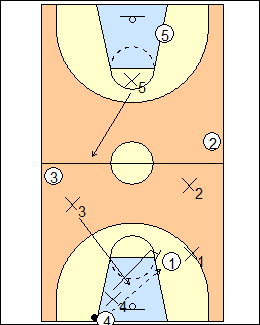Morgan Wootten fullcourt
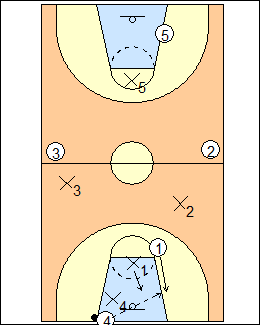 | 1 Morgan Wootten 22-Tough fullcourt is a pressure defence, denying passes all over the court, which is needed when trailing at the end of a game to force a turnover. Defenders do not switch on screens. X4 makes the inbounds pass as difficult as possible by yelling, jumping up and down, waving arms, and staying in the passing lane. X1 plays away from 1 towards the ball with one hand in the passing lane, seeing man and ball, and forcing 1 to the baseline. X2 and X3 play off their men as if they are two passes away so they can deny an inbounds pass and pick off a lob pass to 1, and with their back to the sideline so they can see the entire court and deny cuts to the ball. X5 plays well off 5 to insure he doesn't break open for a pass and to prevent a lob pass to 2 or 3. breakthroughbasketball.com - defending passes down the sideline with your back to the sideline allows you to see the whole floor and more easily defend cuts to the ball, having your back to the middle of the floor is how you play halfcourt defence and gives a better angle to the basket if you get beat deep. Switch on screens, or have xscreener take a couple of steps back to let xcutter through and still deny. Canada Basketball - the inbounds pass can be denied or directed, but in either case a pass to the middle of the floor or behind the first row of the defence must be denied. |
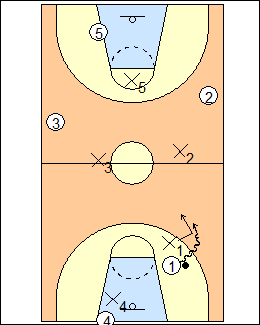 | 2 Once the ball is in play, X1 pressures and contains the dribbler by keeping his head on the ball and turning the dribbler as many times as possible. Other defenders do not allow their players to catch the ball. breakthroughbasketball.com - light fullcourt pressure can be more disruptive and annoying than hard fullcourt pressure. Don't worry about turning the dribbler, just be close enough to disrupt any quick change of direction and make him feel uncomfortable. If a pass is made upcourt, everybody sprints back and matches up. Canada Basketball - good presses must influence the ball in specific directions. |
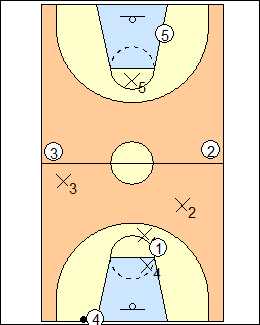 | Variations Shortstop X4 plays between the ball and a receiver (usually the point guard), while X1 plays behind and ballside to complete a double team. If the inbounds pass is made, X4 should recover to guard the inbounder. Mike MacKay - shortstop - X4 face guards the best ballhandler, force someone else to catch the ball and bring it up the floor. The other defenders prevent the ball going long or to the middle. The best way to beat shortstop is to throw long over the top or have the inbounder pass quickly then sprint upcourt before his defender can recover. |
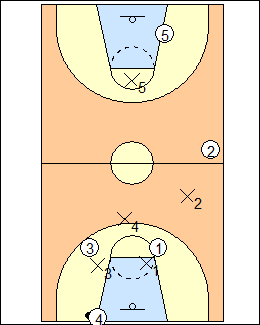 | Centrefield X4 plays at or above the top of the circle to intercept any medium lob pass, cheating ballside because the backboard prevents a lob to the weak side. X1 and X3 can be even more determined about overplaying because the lob is covered. This gives the defence the look of a zone, which can confuse the opposition. Mike MacKay - centrefield - X4 plays behind the primary receivers to intercept a long inbounds pass, X1 and X3 guard the belly button (face guard) and deny cuts to the ball. This works best when trying to get a 5-second count or the other team can't throw long. The best way to beat centrefield is to use a formation where more than one player can go long. |
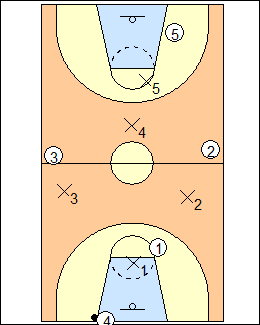 | Leftfield Leftfield is used to prevent a fullcourt inbounds pass. X4 moves into the backcourt, allowing the other defenders to overplay their checks without worrying about a pass over the defence. If an inbounds pass is completed, however, the press is broken by a pass back to the inbounder. (Option) - If the opposition plays with a deep attacker, his defender will also be deep, preventing a fullcourt inbounds pass. X4 can then freelance in the frontcourt, e.g., double team a primary receiver or be a rover at the top of the circle. breakthroughbasketball.com - stick with Centrefield unless you give up two fast-break baskets, then go to Leftfield. Dean Smith - 24 - second-digit 4 signals total pressure (prevent the inbounds pass), the defender of the inbounder is back at halfcourt, preventing a long pass or layup, or comes up to double-team 1 if the other team has a player go long (X1 face guards). 24 all-over - X4 pressures the ball or helps deny 1, used on made foul shots and side-outs (along with 24), usually when a player goes long. 24 is hard to set up after a made field goal, most teams inbound quickly. Del Harris - with short seconds left in a quarter, have the defender of the inbounder back up to halfcourt to play centrefield, he can follow a long inbounds pass to help contain the ball and prevent a shot, if a short inbounds pass is made, he can give help if the ballhandler tries to drive upcourt, or follow a long pass on air time to double team. Mike MacKay - rightfield - X4 plays behind the primary ballhandler, other defenders prevent cuts long or to the middle. Allow 1 to cut to the corner to catch the ball, as long as the inbounder stays behind the ball X4 can shadow the ball and slow it down. This is a good way to slow down a team that wants to go quickly after inbounding. The best way to beat it is to have the inbounder clear upcourt immediately after inbounding. |
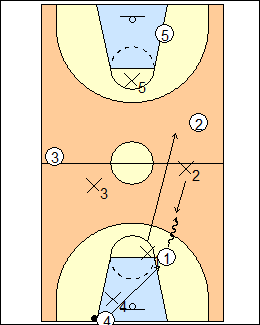 | Blitz switch X1 overplays to direct 1 towards X2, who runs at the dribbler when he is three strides away and switches with X1, coming in under control and in a defensive stance so he doesn't over-run 1.. When X2 reaches 1, X1 breaks off and runs through to pick up 2. Only two players are involved, with no rotation by other players. A blitz switch is very effective after a blitz trap has been run a few times, as 1 may try to pass to 2 and X1 be able to steal it. breakthroughbasketball.com - a fake trap and switch may cause the ballhandler to pick up his dribble with no one to pass to. Dean Smith - run and jump is a rotating man-to-man defence. See Defence - Run and jump. |
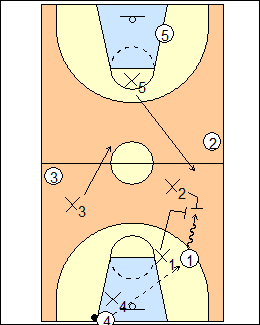 | Blitz trap X1 has two options on the inbounds pass, he can for force 1 to the sideline for a fan trap, or to the middle for a funnel trap. a) Fan trap X1 forces sideline, X2 releases from 2 when 1 is three strides away and traps with X1. X5 rotates up to pick up X2, running through the passing lane for a potential steal. X4 takes away the pass back to the inbounder and X3 drops to play between deep attackers 5 and 3, reading the trap, judging which attacker is most dangerous and cheating in that direction. breakthroughbasketball.com - for a basic fullcourt press, extend your man-to-man defence to fullcourt, except you will most likely be denying most passes. With youth teams don't worry about trapping or back-to-the-sideline positioning. Dean Smith (fullcourt scramble) - a trap is keyed when 1 puts the ball on the floor. X4 is back when the ball is out of bounds (e.g. behind 1), the same look as 24, deny the inbounds pass after a made free throw. See Defence - Tar Heels scramble. |
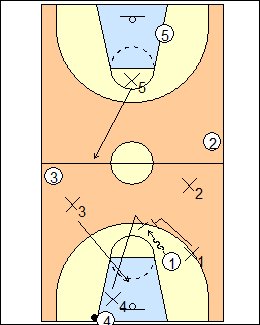 | b) Funnel trap X1 forces 1 to the middle into a trap with X4. X3 rotates up into the passing lane back to the inbounder, X2 stays with his man, X5 rotates up and plays between 5 and 3. The deep pass is left unguarded but this is a tough pass. (A funnel trap is more of a gamble than a sideline trap since the passing angles out of it are better) Dean Smith - X2 would double-team with X1 if 1 dribbles up the sideline. |
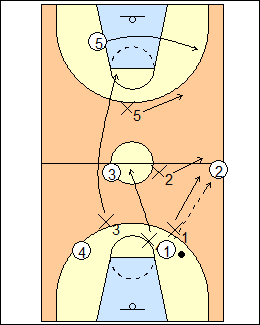 | 9 Dean Smith X2 and X3 are interceptors, X5 is the goaltender (a 2-2-1 zone press). On a perimeter pass to 2, - X1 turns and chases the ball (the pass was thrown in his direction) - X2 double teams with X1 (the pass was thrown in his direction) - X4 becomes an interceptor - goaltender X5 becomes an interceptor - interceptor X3 becomes goaltender (the pass was thrown opposite his direction). They can double-team until the ball penetrates past the hash marks in their backcourt, then sprint back, talk, pick up their men. If 1 passes to 4, X3 traps with X4, X5 and X1 are interceptors, X2 is goaltender. If 1 makes a gut pass to 3, X1 and X4 sprint back into man-to-man defence (22). |
This page was made with Basketball playbook from Jes-Soft
